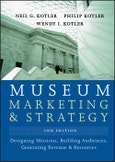The SECOND EDITION of A GROUNDBREAKING BOOK
This newly revised and updated edition of the classic resource on museum marketing and strategy provides a proven framework for examining marketing and strategic goals in relation to a museum′s mission, resources, opportunities, and challenges. Museum Marketing and Strategy examines the full range of marketing techniques and includes the most current information on positioning, branding, and e–marketing. The book addresses the issues of most importance to the museum community and shows how to
- Define the exchange process between a museum′s offerings and consumer value
- Differentiate a museum and communicate its unique value in a competitive marketplace
- Find, create, and retain consumers and convert visitors to members and members to volunteers and donors
- Plan strategically and maximize marketing′s value
- Achieve financial stability
- Develop a consumer–centered museum
The book is filled with examples of best practices, programs, problem solving, and organizational behavior. Ten case studies illuminate marketing solutions with contributions from international museum professionals including Ruth Rentschler, Kazuharu Ishida, Sarah Briggs, Mario Bucolo, and Yutaka Mino.
PRAISE FOR Museum Marketing and Strategy
"The Kotlers have written a much needed, up–to–date, comprehensive road map for effective leadership. There is a rich lode of stories and strategies for the museum executive in a digital world a tour de force."
JOHN W. McCARTER, JR., CEO and president, The Field Museum, Chicago, Illinois
"The most comprehensive and insightful guide to effectively addressing the challenges facing museums in the changing and uncertain global, digital, and consumer empowered environment. Illustrated with a trove of rich cases of model museum practices around the world, this book is a must–read to all museum management and boards."
YORAM (JERRY) WIND, The Lauder Professor and professor of marketing, the Wharton School, University of Pennsylvania, and trustee, Philadelphia Museum of Art
Table of Contents
Figures, Tables, and Exhibits.Model Museum Practices.
Preface.
Acknowledgments.
The Authors.
PART ONE: MUSEUMS AND MARKETING.
1. The Diverse World of Museums.
Museum Experiences.
What Is a Museum?.
Origin and Evolution of Museums.
Summary.
2. The Role of Museum Marketing.
Exchange Transactions and Relationships.
The Role of a Marketer.
The Marketing Concept.
Strategic Marketing.
Marketing Core Concepts.
Developing Marketing Plans.
Characteristics of a Consumer–Centered Museum.
The Impact of the Digital Revolution on Marketing.
Summary.
Model Museum Practice: Museum of Science, Boston.
PART TWO: STRATEGIC MARKETING.
3. Moving to Strategic Planning.
Strategic Planning.
Strategic Market Planning Process.
The Environmental Scan.
Undertaking a Marketing Audit.
Summary.
Model Museum Practice: National Gallery of Victoria.
4. Choosing a Mission and Core Strategy.
A Museum Chooses Its Mission.
Setting the Core Marketing Strategy.
Product Portfolio Strategy.
Organizational Structure and Culture.
Human Resources.
Summary.
Model Museum Practice: The Strong National Museum of Play.
5. Applying Market Segmentation, Targeting, Positioning, and Branding.
Approaches to Markets.
Steps in Segmenting, Targeting, and Positioning.
Bases for Segmenting Markets.
Targeting Specific Market Segments.
Positioning the Museum and Its Offerings.
Museum Branding and Brands.
Summary.
Model Museum Practice: Chicago History Museum.
PART THREE: MUSEUM CHALLENGES AND OPPORTUNITIES.
6. Building Audiences.
Attracting and Retaining an Audience.
Attracting New Audiences.
Information Gathering.
Decision Evaluation.
Decision Execution.
Postpurchase Assessment and Action.
Summary.
Model Museum Practice: Fonthill Museum.
7. Attracting Financial Resources.
The Impact of Economic Cycles on Museums.
Museum Revenue Sources.
Government Support.
Earned Income.
Attracting and Managing Donors.
Fundraising Goals and Strategy.
Investment Income.
Improving Business Practices to Augment Income.
Financing Opportunities.
Summary.
Model Museum Practice: The Freer and Sackler Galleries.
PART FOUR: TACTICAL MARKETING.
8. Carrying Out Marketing Research.
Museum Applications of Marketing Research.
Major Types of Museum Research.
Before Beginning the Research.
Data Sources and Research Tools.
Steps in the Marketing Survey Process.
Marketing Research Budgeting.
Resistance to Marketing Research.
Summary.
Model Museum Practice: The Newark Museum.
9. Developing Attractive Offerings.
Collections and Exhibitions.
Museum Programs.
Museum Experiences.
Museum Services.
Purchasable Products.
Summary.
Model Museum Practice: 21st Century Museum of Contemporary Art, Kanazawa.
10. Distributing the Museum s Offerings and Services.
Distribution Channel Structure.
Branch Museums.
Traveling Exhibitions and Loans.
Off–Site Programs.
Museum Retail Channels.
Museum Publications.
Electronic Distribution.
Consumer Convenience.
Summary.
Model Museum Practice: Great Britain s Tate.
11. Managing Marketing Communications.
The Communication Process.
Advertising.
Sales Promotion.
Direct Marketing.
Public Relations.
Summary.
Model Museum Practice: Museums and E–Communication.
12. Setting Pricing Strategies.
Pricing Admission.
Pricing Objects Loaned to Other Museums.
Pricing Special Exhibitions and Events.
Pricing Membership.
Pricing Museum Shop Items.
Pricing Facility Rental.
Pricing Donor Support.
Summary.
13. Managing Marketing Operations.
Developing Marketing Budgets.
Marketing Implementation.
Power Relationships in Organizations.
Marketing Information and Control Systems.
Summary.
CONCLUSION.
14. Securing the Future of Museums.
Museums and Marketing.
Achieving Expanded and Diverse Audiences.
Expanding Capacity and Developing Exhibitions and Programs.
Museum Partnerships.
Encouraging Future Visitors and Experiences.
Online Resources.
References.
Index.








